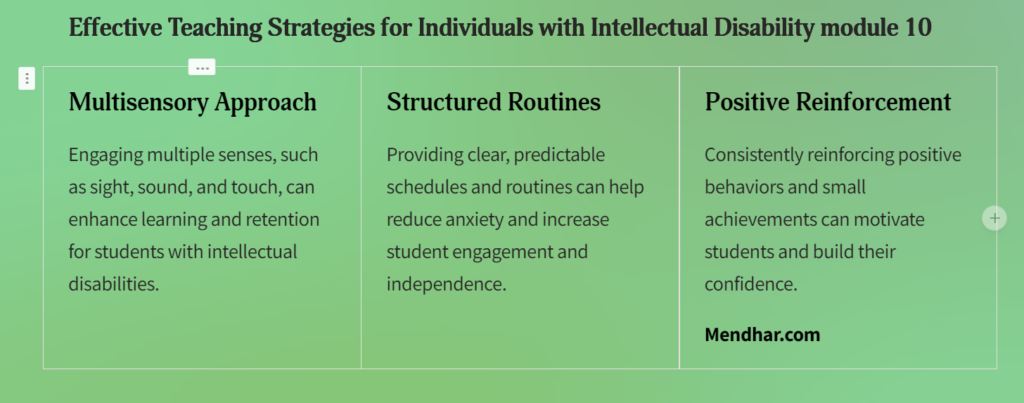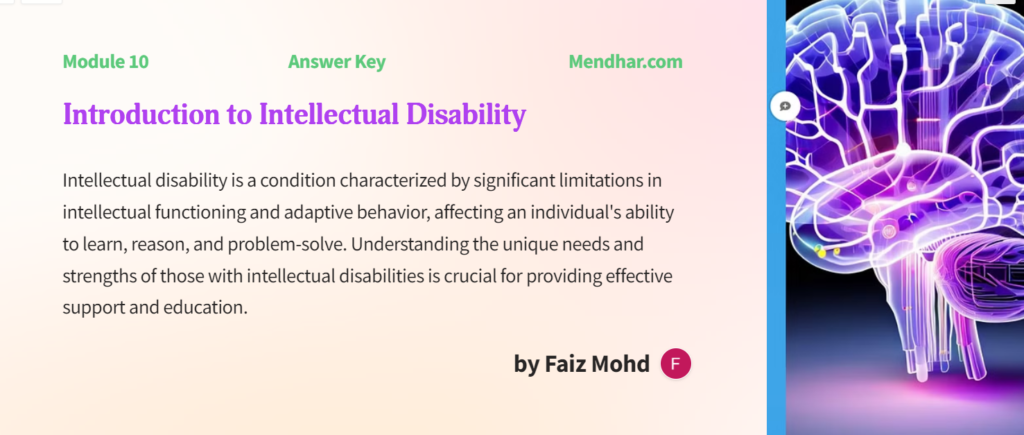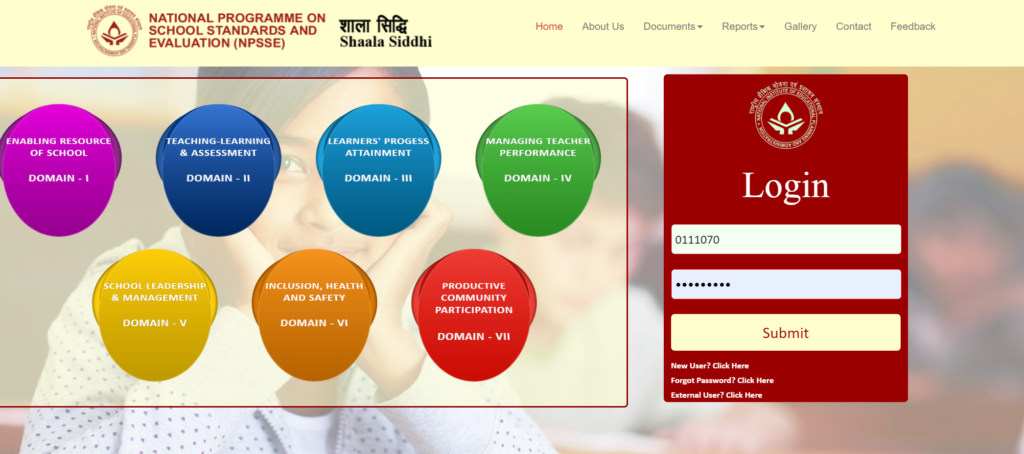Introduction to intellectual disability:Teaching strategies-Module 10

Teaching individuals with intellectual disabilities requires a multifaceted approach that recognizes their unique needs, abilities, and learning styles. Effective teaching strategies aim to empower these individuals by providing tailored support and opportunities for growth. Here are some key teaching strategies for intellectual disability:
Individualized Education Plans (IEPs): Developing IEPs tailored to each student’s strengths, needs, and goals is essential. These plans outline specific educational objectives, accommodations, and support services to ensure personalized learning experiences.
Multisensory Instruction: Utilizing multisensory approaches engages multiple senses (such as sight, touch, and hearing) to enhance learning and retention. This may include hands-on activities, visual aids, and interactive materials to reinforce concepts.
Differentiated Instruction: Adapting teaching methods and materials to accommodate diverse learning needs is crucial. Teachers can modify content, pace, and delivery methods to meet students at their individual skill levels and promote success.
Visual Supports: Visual supports, such as visual schedules, cue cards, and pictorial instructions, can help individuals with intellectual disabilities understand expectations, organize tasks, and navigate daily routines more effectively.
Positive Reinforcement: Encouraging and reinforcing desired behaviors and achievements with praise, rewards, and encouragement fosters motivation and self-confidence in students with intellectual disabilities.
Peer Support and Collaboration: Facilitating peer interactions and collaborative learning opportunities promotes social skills development, peer acceptance, and inclusive classroom environments.
Assistive Technology: Incorporating assistive technology tools and devices, such as communication aids, educational software, and adaptive equipment, can facilitate access to the curriculum and support independence in learning.
Community-Based Instruction: Providing opportunities for real-world learning experiences in community settings, such as grocery stores or libraries, helps generalize skills and promote functional independence in daily life.

Intellectual disability:Teaching strategies-Module 10
1). Multisensory spelling strategies give students more than one way to connect with what they are learning.
a)True
b)False
Answer: a)TRUE✅
2). For Teaching any concept, it is often advised to move from:
- a) Concrete to Abstract
- b) Abstract to Concrete
- c) Just do concrete first
- d) Depends on the disability of the child
Answer: a) Concrete to Abstract✅
3). The CPA approach is:
- a) Concrete, Pictorial, Abstract
- b) Concept, Picture, Addition
- c) Concrete, Plus, Abstract
- d) Carry over, Plus, Abstract
Answer: a) Concrete, Pictorial, Abstract✅
4). It is important to compel the child to do neat work, it is not proper to replace the written task with the help of oral presentation, gestures or flashcards.
TRUE✅
5). Social stories can be used to teach:
- a) Social skill
- b) Motor skill
- c) Gross motor skill
- d) Fine motor skill
Answer: a) Social skill✅
Introduction to Intellectual Disability: Module 10 Answer Key
6). Before introducing the symbols such as plus (+) or equal to (=), the same concepts have to be developed using familiar objects and situations.
TRUE✅
7). One of the techniques of implementing multisensory spelling strategies for learning is:
- a) ABC technique
- b) BBB technique
- c) CCC technique
- d) CBA technique
Answer: d) CBA technique✅
8). Social skills help children with intellectual disabilities (ID) build strong and positive relationships with their peers and be successful in school.
TRUE✅
9). Students with ID face difficulties with learning concepts and new information.
TRUE✅
10). Choose the correct sequence of stages of development of mathematical concepts in children:
- a) Concrete, Semi-Concrete, Semi-Abstract, Abstract
- b) Abstract, Concrete, Semi-Concrete, Semi-Abstract
- c) Semi-Concrete, Concrete, Semi-Abstract, Abstract
- d) Concrete, Semi-Abstract, Semi-Concrete, Abstract
Answer: a) Concrete, Semi-Concrete, Semi-Abstract, Abstract✅

Intellectual disability:Teaching strategies-Module 10
11). Learning spelling with the help of computers can help develop and enhance linguistic skills and vocabulary.
TRUE✅
12). Social skills help children with intellectual disabilities (ID) build strong and positive relationships with their peers and be successful in school.
TRUE✅
13). The Play Way Method approach is a method of learning that enables overall development of feelings, intellect and skills parameters in children.
TRUE✅
14). It is important to compel the child to do neat work, it is not proper to replace the written task with the help of oral presentation, gestures or flashcards.
FALSE✅
15). Social skills help children with intellectual disabilities (ID) build strong and positive relationships with their peers and be successful in school.
TRUE✅
Introduction to Intellectual Disability: Module 10 Answer Key
16). Social Stories can be used to teach:
- a) Social skill
- b) Motor skill
- c) Gross motor skill
- d) Fine motor skill
Answer: a) Social skill✅
17). One of the techniques of implementing multisensory spelling strategies for learning is:
- a) ABC technique
- b) BBB technique
- c) CCC technique
- d) CBA technique
Answer: d) CBA technique✅
18). Before introducing the symbols such as plus (+) or equal to (=), the same concepts have to be developed using familiar objects and situations.
TRUE✅
19). Social skills help children with intellectual disabilities (ID) build strong and positive relationships with their peers and be successful in school.
TRUE✅
20). Students with ID face difficulties with learning concepts and new information.
TRUE✅
21). Social skills help children with intellectual disabilities (ID) build strong and positive relationships with their peers and be successful in school.
TRUE✅
22). The Play Way Method approach is a method of learning that enables overall development of feelings, intellect and skills parameters in children.
TRUE✅
23). Learning spelling with the help of computers can help develop and enhance linguistic skills and vocabulary.
TRUE✅
24). Social skills help children with intellectual disabilities (ID) build strong and positive relationships with their peers and be successful in school.
TRUE✅
25). It is important to compel the child to do neat work, it is not proper to replace the written task with the help of oral presentation, gestures or flashcards.
FALSE✅

Government Initiatives in Inclusive Education: Sri Aurobindo Society
In India, inclusive education is a priority area for the government, aiming to ensure equal access to quality education for all children, including those with disabilities. The Sri Aurobindo Society, a prominent non-profit organization, has been actively involved in promoting inclusive education initiatives across the country.
The Sri Aurobindo Society’s inclusive education initiatives focus on:
Capacity Building: The organization conducts training programs and workshops for teachers, educators, and school administrators to enhance their knowledge and skills in inclusive teaching practices. These capacity-building efforts aim to create supportive learning environments that cater to the diverse needs of students.
Resource Development: Sri Aurobindo Society develops educational resources, materials, and curriculum frameworks that align with inclusive education principles. These resources provide practical guidance and support for educators in implementing inclusive practices in classrooms.
Advocacy and Awareness: The society advocates for policy reforms and initiatives that promote inclusive education and raise awareness about the rights and needs of individuals with disabilities. By advocating for inclusive policies and practices, they strive to create more inclusive and accessible educational opportunities for all learners.
Community Engagement: Sri Aurobindo Society engages with local communities, parents, and stakeholders to foster greater acceptance, understanding, and support for inclusive education. By involving communities in the education process, they aim to create inclusive societies that value diversity and inclusion.



Pingback: Dyslexia: Teaching Strategies - Module 11 -